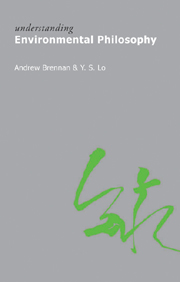Book contents
- Frontmatter
- Contents
- Acknowledgements
- 1 Introduction: the place of environmental philosophy and its basic concepts
- 2 Future generations: what consideration do we owe them?
- 3 Animals: are they as morally valuable as human beings?
- 4 Living things: ethics for the non-human world
- 5 Community: how big is our moral world?
- 6 Natural things: the puzzle of what “natural” means, and whether humans belong to nature
- 7 Foundations: can there be a secular basis for the ideas of human dignity and intrinsic value in nature?
- 8 Origins: political, religious and cultural diagnoses of environmental problems
- 9 Beyond individual responsibility: governance and the affluenzic society
- Questions for discussion and revision
- Further reading
- Bibliography
- Index
7 - Foundations: can there be a secular basis for the ideas of human dignity and intrinsic value in nature?
- Frontmatter
- Contents
- Acknowledgements
- 1 Introduction: the place of environmental philosophy and its basic concepts
- 2 Future generations: what consideration do we owe them?
- 3 Animals: are they as morally valuable as human beings?
- 4 Living things: ethics for the non-human world
- 5 Community: how big is our moral world?
- 6 Natural things: the puzzle of what “natural” means, and whether humans belong to nature
- 7 Foundations: can there be a secular basis for the ideas of human dignity and intrinsic value in nature?
- 8 Origins: political, religious and cultural diagnoses of environmental problems
- 9 Beyond individual responsibility: governance and the affluenzic society
- Questions for discussion and revision
- Further reading
- Bibliography
- Index
Summary
Sources of intrinsic value
So far in this book we have explored the writings of environmental philosophers, and have placed these to some extent in a wider historical context. To make any more progress in exploring the idea of value in nature, we need to look specifically at the philosophical and religious contexts within which ideas of intrinsic value or inherent worth have developed. At the end of Chapter 6, we noted the tensions in the ideas associated with nature, for example between nature as a place of dread and awe, and nature as a place of self-discovery and self-creation. Sometimes nature is regarded as a place of sanctuary, and associated with the term “sanctuary” are religious connotations of the sacred. Yet “sacred” is an anagram of “scared”, and whether we can retreat to the wild as a place of security, or instead enter it with a sense of danger will very much depend on where we live. Different environments provide different degrees of security and danger. A delightfully sunny morning at high altitude may awaken a sense of wariness in the experienced mountaineer, just as an invitingly calm sea never tempts the prudent sailor to neglect to keep an eye on the weather. There seems to be a gap of a serious kind between these well-known facts on the one side and, on the other, the emergence of claims by philosophers that natural things have intrinsic value, that nature in general is worthy of respect as an end-in-itself, and that we should enter into respectful dialogue with other beings and systems.
- Type
- Chapter
- Information
- Understanding Environmental Philosophy , pp. 138 - 162Publisher: Acumen PublishingPrint publication year: 2010



